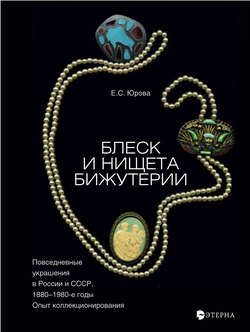Блеск и нищета бижутерии. Повседневные украшения в России и СССР, 1880–1980 годы

Реклама. ООО «ЛитРес», ИНН: 7719571260.
Оглавление
Елена Юрова. Блеск и нищета бижутерии. Повседневные украшения в России и СССР, 1880–1980 годы
Summary
Предыстория
«Русские» бусы
Фальшивки
От фальшивки до ар-нуво
От ар-нуво до хлебного мякиша
От хлебного мякиша к Яблонексу
Первые ласточки советской бижутерии
Расцвет советского модерна (1960-е годы)
Народный стиль (1970-е годы)
Полная реабилитация бижутерии (1980-е годы)
Паломничество по местам изготовления стеклянных бус
Украшения и их владелицы
Приложение. Как носить кольца
Отрывок из книги
During nearly 50 years our family collected old Russian beadwork. After the collapse of the Soviet Union in 1991 we had the opportunity to correspond with foreigners and to visit foreign countries. For me the communication with colleagues about bead collecting seemed to be especially interesting. So in 2004 I came to the Annual Bead Fair of the Bead Society of Great Britain. There for the first time I made the acquaintance of the founders of BSGB: Stefany Tomalin and Carole Morris. Stefany was so kind as to invite me for a dinner (N1.1). She showed me her outstanding collection of beads and during our conversation she asked me what are typical Russian beads. This simple question surprised me, and on returning home, I started to look for a convincing answer.
After studying a lot of Russian portraits, I came to the conclusion that in the 18–19th centuries our women from a peasant to the Empress preferred pearl necklaces. The only difference between them was the size of the pearls: the elaborate netting of tiny river pearls or a magnificent necklace of enormous impeccable pearls (ill. 2, 3). The wide application of pearls in the folk costume was possible, because in the past pearls could be found in almost all rivers in the North of Russia.
.....
Despite all the difficulties of wartime the desire of girls to look attractive was ineradicable. This can be proved in a photo of a young peasant girl, made in the midst of war (1943) (ill. 79). Most probably, she took this attire from her mother’s dower chest to make the photo and send it to her friend.
Closer to the end of war parcels with foreign dresses and jewelry began to come to Russia more and more often. Furthermore in shops jewelry appeared made of bohemian garnets (ill. 80). For the first time Russian women had the opportunity to get something fashionable. Most in demand by them were short beads and brooches with transparent stones (ill. 83). No less fashionable were also necklaces of opaque white glass and braided strands of beads (ill. 84-85b).
.....